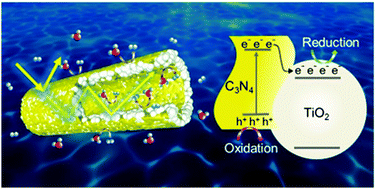Hydrogen evolution and dye degradation catalyzed by environmentally benign and inexpensive photocatalyst in aqueous solution is regarded as a promising avenue to effectively address the global energy and environmental crisis. It is difficult for traditional photocatalysts to perform efficient light harvesting, with conducive recycling and promoted charge separation and transport, which limit practical applications in photocatalytic conversion. In this study, a facile template-assisted coaxial electrospinning approach was explored to successfully build close contacted heterojunctions within the interface of g-C3N4 nanosheets and hollow porous TiO2 nanofibers, which significantly increased the separation efficiency of photo-induced electron–hole pairs in the visible-light region. A hollow and porous structure with abundant surface-active sites assisted in inducing multiple light reflection for more efficient light harvesting. Moreover, one dimensional TiO2/g-C3N4 composite nanofibers with a large length-to-diameter ratio would be more attractive for recovery. At the optimal g-C3N4 loading, hollow porous TiO2/g-C3N4-50% nanofibers exhibited the highest rate of hydrogen evolution and RhB degradation. The enhanced photocatalytic performance of hollow porous TiO2/g-C3N4 composite photocatalysts was mainly attributed to the synergistic effect of the hollow porous architecture and heterojunction. This work might make a significant contribution to insight into preparing hollow structure heterogenous nanofiber photocatalysts with improved activities in hydrogen generation and pollutant degradation.

